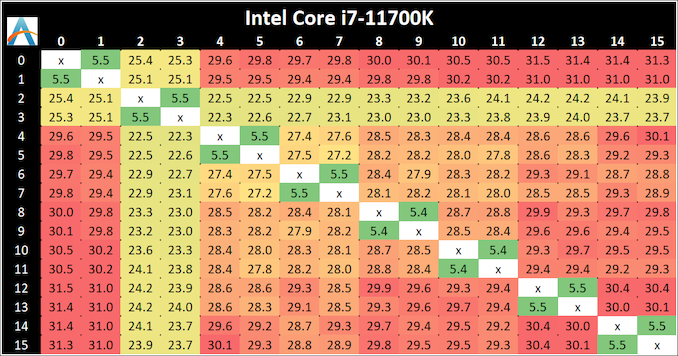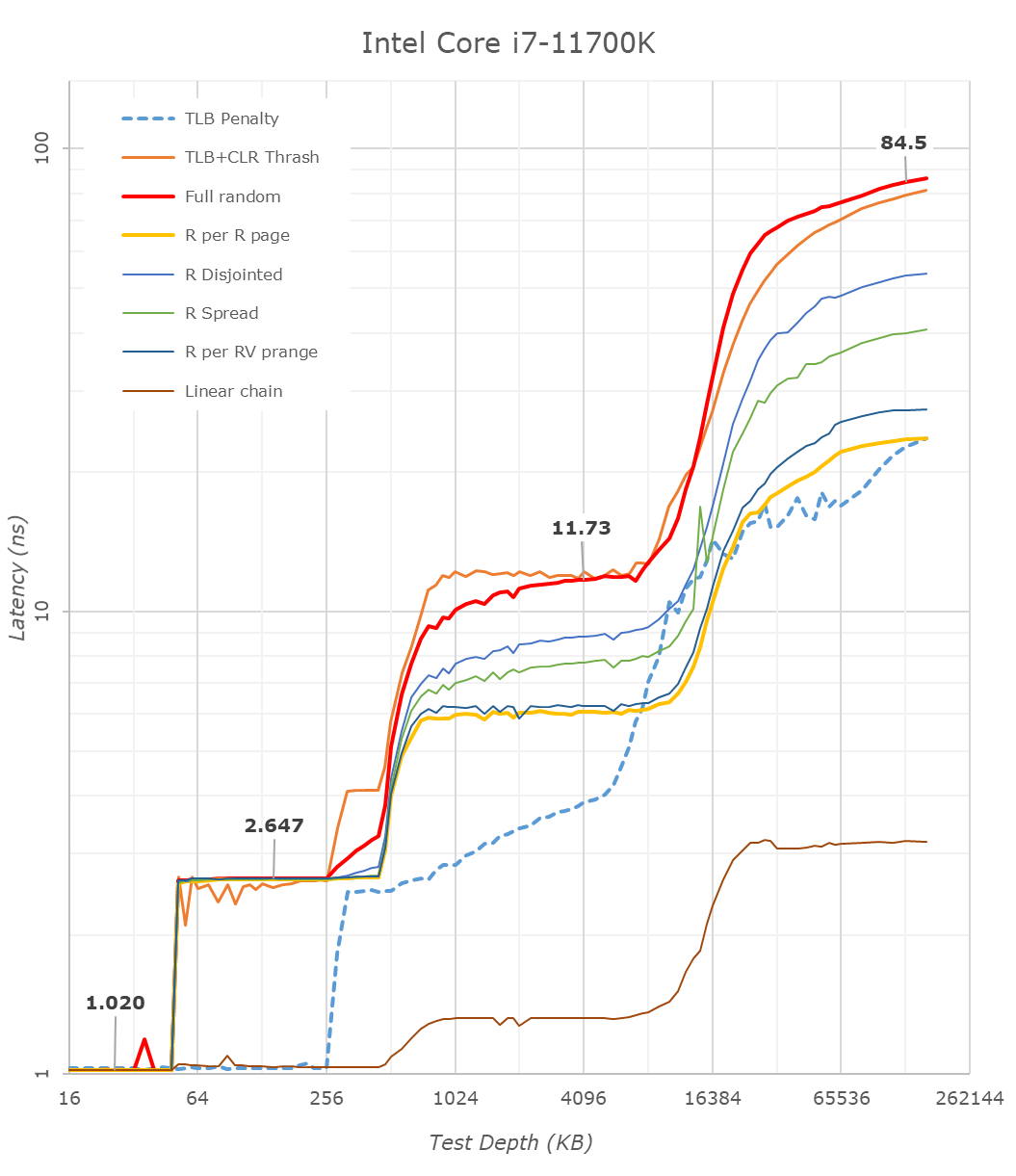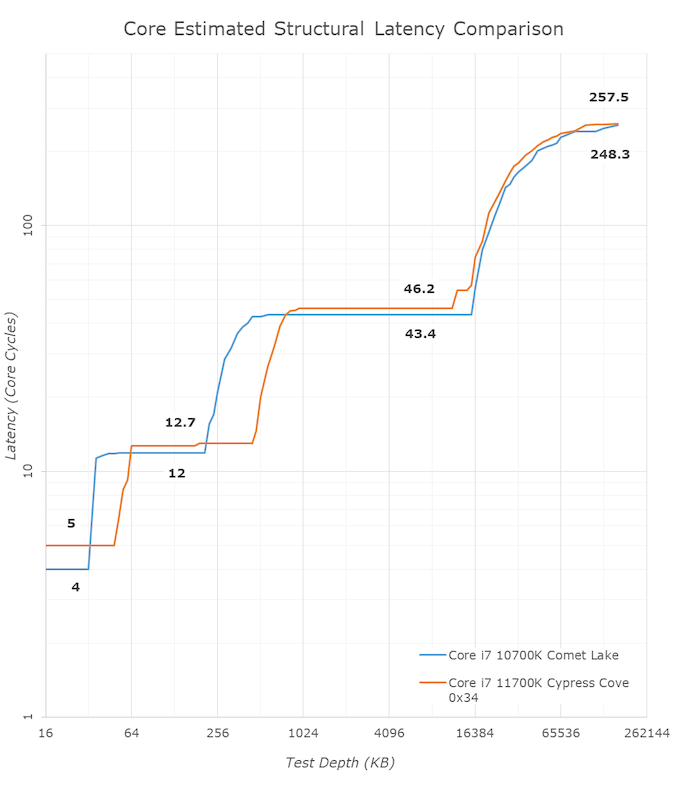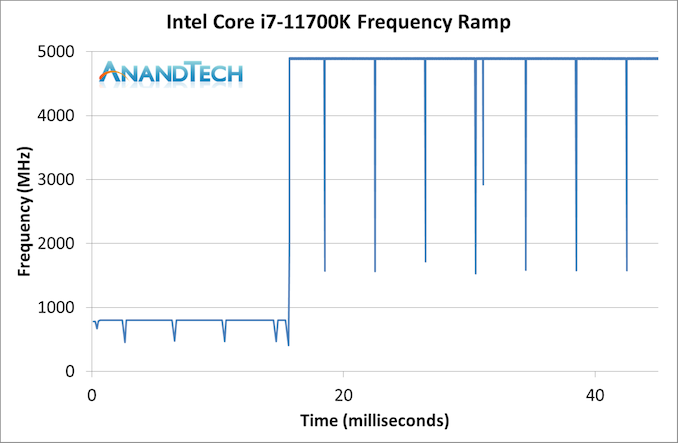Intel Core i7-11700K Review: Blasting Off with Rocket Lake
by Dr. Ian Cutress on March 5, 2021 4:30 PM EST- Posted in
- CPUs
- Intel
- 14nm
- Xe-LP
- Rocket Lake
- Cypress Cove
- i7-11700K
CPU Tests: Microbenchmarks
Core-to-Core Latency
As the core count of modern CPUs is growing, we are reaching a time when the time to access each core from a different core is no longer a constant. Even before the advent of heterogeneous SoC designs, processors built on large rings or meshes can have different latencies to access the nearest core compared to the furthest core. This rings true especially in multi-socket server environments.
But modern CPUs, even desktop and consumer CPUs, can have variable access latency to get to another core. For example, in the first generation Threadripper CPUs, we had four chips on the package, each with 8 threads, and each with a different core-to-core latency depending on if it was on-die or off-die. This gets more complex with products like Lakefield, which has two different communication buses depending on which core is talking to which.
If you are a regular reader of AnandTech’s CPU reviews, you will recognize our Core-to-Core latency test. It’s a great way to show exactly how groups of cores are laid out on the silicon. This is a custom in-house test built by Andrei, and we know there are competing tests out there, but we feel ours is the most accurate to how quick an access between two cores can happen.
The core-to-core numbers are interesting, being worse (higher) than the previous generation across the board. Here we are seeing, mostly, 28-30 nanoseconds, compared to 18-24 nanoseconds with the 10700K. This is part of the L3 latency regression, as shown in our next tests.
One pair of threads here are very fast to access all cores, some 5 ns faster than any others, which again makes the layout more puzzling.
Update 1: With microcode 0x34, we saw no update to the core-to-core latencies.
Cache-to-DRAM Latency
This is another in-house test built by Andrei, which showcases the access latency at all the points in the cache hierarchy for a single core. We start at 2 KiB, and probe the latency all the way through to 256 MB, which for most CPUs sits inside the DRAM (before you start saying 64-core TR has 256 MB of L3, it’s only 16 MB per core, so at 20 MB you are in DRAM).
Part of this test helps us understand the range of latencies for accessing a given level of cache, but also the transition between the cache levels gives insight into how different parts of the cache microarchitecture work, such as TLBs. As CPU microarchitects look at interesting and novel ways to design caches upon caches inside caches, this basic test proves to be very valuable.
Looking at the rough graph of the 11700K and the general boundaries of the cache hierarchies, we again see the changes of the microarchitecture that had first debuted in Intel’s Sunny Cove cores, such as the move from an L1D cache from 32KB to 48KB, as well as the doubling of the L2 cache from 256KB to 512KB.
The L3 cache on these parts look to be unchanged from a capacity perspective, featuring the same 16MB which is shared amongst the 8 cores of the chip.
On the DRAM side of things, we’re not seeing much change, albeit there is a small 2.1ns generational regression at the full random 128MB measurement point. We’re using identical RAM sticks at the same timings between the measurements here.
It’s to be noted that these slight regressions are also found across the cache hierarchies, with the new CPU, although it’s clocked slightly higher here, shows worse absolute latency than its predecessor, it’s also to be noted that AMD’s newest Zen3 based designs showcase also lower latency across the board.
With the new graph of the Core i7-11700K with microcode 0x34, the same cache structures are observed, however we are seeing better performance with L3.
The L1 cache structure is the same, and the L2 is of a similar latency. In our previous test, the L3 latency was 50.9 cycles, but with the new microcode is now at 45.1 cycles, and is now more in line with the L3 cache on Comet Lake.
Out at DRAM, our 128 MB point reduced from 82.4 nanoseconds to 72.8 nanoseconds, which is a 12% reduction, but not the +40% reduction that other media outlets are reporting as we feel our tools are more accurate. Similarly, for DRAM bandwidth, we are seeing a +12% memory bandwidth increase between 0x2C and 0x34, not the +50% bandwidth others are claiming. (BIOS 0x1B however, was significantly lower than this, resulting in a +50% bandwidth increase from 0x1B to 0x34.)
In the previous edition of our article, we questioned the previous L3 cycle being a larger than estimated regression. With the updated microcode, the smaller difference is still a regression, but more in line with our expectations. We are waiting to hear back from Intel what differences in the microcode encouraged this change.
Frequency Ramping
Both AMD and Intel over the past few years have introduced features to their processors that speed up the time from when a CPU moves from idle into a high powered state. The effect of this means that users can get peak performance quicker, but the biggest knock-on effect for this is with battery life in mobile devices, especially if a system can turbo up quick and turbo down quick, ensuring that it stays in the lowest and most efficient power state for as long as possible.
Intel’s technology is called SpeedShift, although SpeedShift was not enabled until Skylake.
One of the issues though with this technology is that sometimes the adjustments in frequency can be so fast, software cannot detect them. If the frequency is changing on the order of microseconds, but your software is only probing frequency in milliseconds (or seconds), then quick changes will be missed. Not only that, as an observer probing the frequency, you could be affecting the actual turbo performance. When the CPU is changing frequency, it essentially has to pause all compute while it aligns the frequency rate of the whole core.
We wrote an extensive review analysis piece on this, called ‘Reaching for Turbo: Aligning Perception with AMD’s Frequency Metrics’, due to an issue where users were not observing the peak turbo speeds for AMD’s processors.
We got around the issue by making the frequency probing the workload causing the turbo. The software is able to detect frequency adjustments on a microsecond scale, so we can see how well a system can get to those boost frequencies. Our Frequency Ramp tool has already been in use in a number of reviews.
Our ramp test shows a jump straight from 800 MHz up to 4900 MHz in around 17 milliseconds, or a frame at 60 Hz.














541 Comments
View All Comments
emperoralku - Saturday, March 6, 2021 - link
Bulldozer, is that you? Or are you the cpu version of vega?GeoffreyA - Saturday, March 6, 2021 - link
I think the latter. Just imagine when this thing collapses into a singularity ;)DannyH246 - Saturday, March 6, 2021 - link
What a load of crap. Hot, late, slow. The biggest joke of all is this site actually recommends you buy one “because you can get one”. I didn’t think this place could sink any lower. I was wrong.Spunjji - Monday, March 8, 2021 - link
That's an odd interpretation of what was actually saidRauli Trump - Saturday, March 6, 2021 - link
what ram subtimings where used on 11700klyssword - Saturday, March 6, 2021 - link
Wow, finally upgraded gpu from gtx 980 for gaming tests, good job anandtech!WaltC - Saturday, March 6, 2021 - link
One thing I think that is of interest to people is what security holes have been filled with these newer Intel CPUs, if any, and were these benchmarks run with OS and firmware security mitigations in place? My guess would be: no. It's not really an issue for AMD as that story is well known--1 or possibly 2 mitigations in place--both were handled in firmware for Zen2, probably neither is a problem for Zen 3. Intel, otoh, has been cursed with dozens of security holes patched with Windows microcode patching & firmware patching for quite a while. An update on the situation would have been thoughtful. I don't think Intel believes it is ready to compete just yet.Spunjji - Monday, March 8, 2021 - link
AFAIK this core design is hardened at the hardware level against Spectre and Meltdown.GeoffreyA - Saturday, March 6, 2021 - link
Thanks for the excellent work, Ian. While it hasn't displaced Ryzen, I commend Intel for the effort that Rocket Lake is. Zen 3's architecture is a lot lighter, which suggests that Intel may have to curtail theirs in the next round. Starting from scratch might be of use but will take a few iterations before catching up with Zen.iGigaflop - Saturday, March 6, 2021 - link
Well I finally got my 5950x a couple days ago but I did order it December 15th on special order so it took awhile I think I payed $850ish for it with tax. I was thinking 11th gen intel was gonna be better than this hell seems like 10th gen the smarter bet and going with a 10900k or one of the close versions if you wanted intel. But overall amd is killing intel in every section of the market. I couldn’t imagine this about 5 years ago especially in the laptop market where 7nm efficiency really helps. Now if they can get it together with their gpu’s, the 6000 series is great and all but if you gave most people the choice i still think they would pick a 3080 over a 6800xt. Ray tracing performance is nice but it’s the dlss really helping nvidia. I have a strix 2080ti with a 9900ks right now as my main gaming rig and a 3900x radeon vii for my work/gaming rig. I’m gonna put the ti with the 5950x but I wanted to find a 3080/3090 for the build but I have gave up for now. Hell I need to sell a bunch of my gpu’s while the market is crazy. I have a strix 2080, nitro 5700xt se, msi gaming x 1080, and a couple more thats just collecting dust.